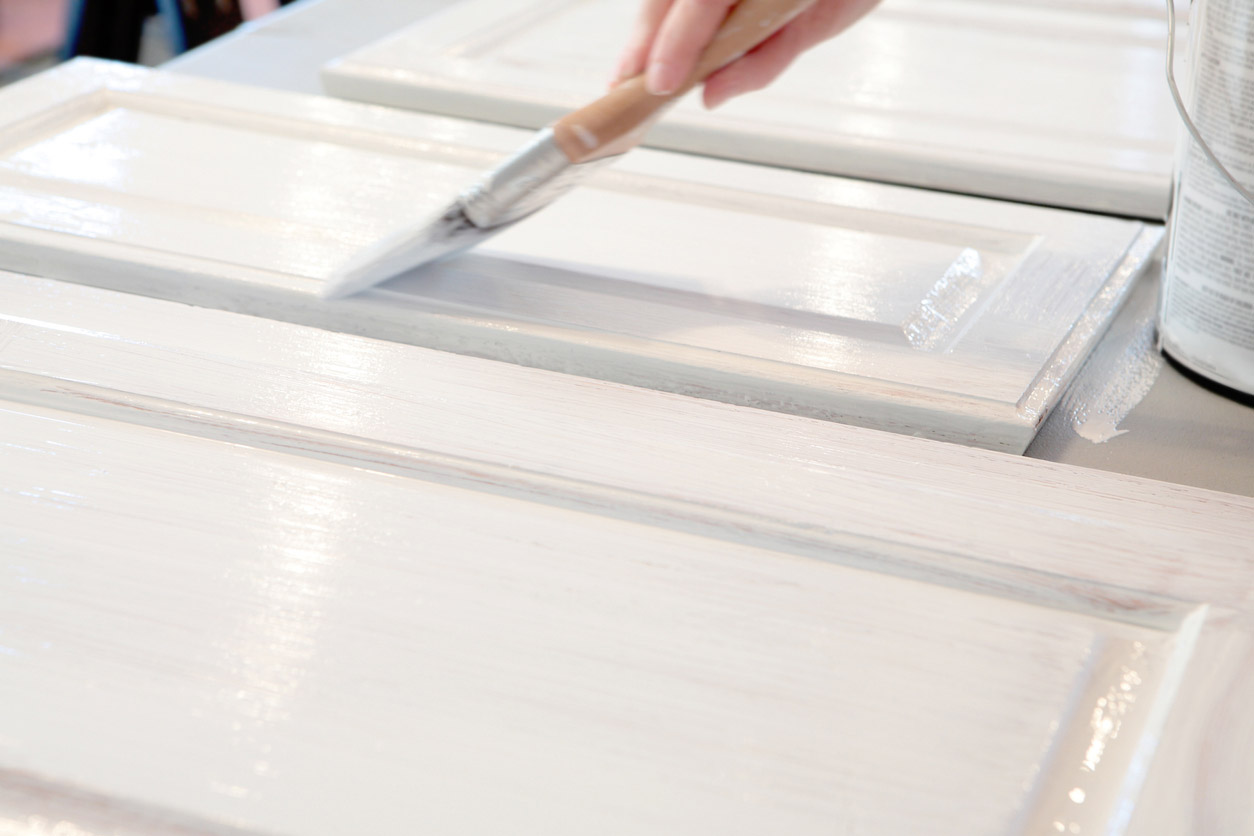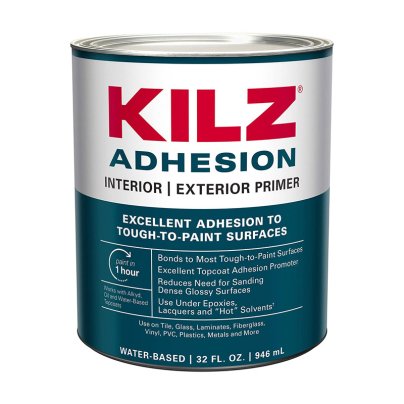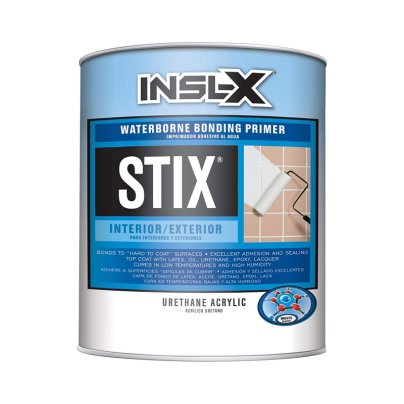
We may earn revenue from the products available on this page and participate in affiliate programs. Learn More ›
A good general-purpose primer is the starting point for the vast majority of quality paint finishes, as it helps paint adhere to the surface. But painting kitchen cabinets presents a number of particular challenges when it comes to choosing a primer. Popular laminate cabinets, particularly the easy-clean surface of formica, can be tricky because they present adhesion problems. And while the fashionable effect of glazing kitchen cabinets doesn’t necessarily require a primer, it remains a worthwhile step if changing the underlying color.
Fortunately, there is a wide range of primers available. Use this guide to learn which products are most suitable for particular surfaces and explore a host of options considered among the best primers for kitchen cabinets, regardless of material or its condition.
- BEST OVERALL: KILZ Adhesion Primer, Interior/Exterior
- BEST BANG FOR THE BUCK: Zinsser Bulls-Eye 1-2-3 Acrylic Primer and Sealer
- BEST BONDING: INSL-X SXA11009A-04 Stix Acrylic Waterborne Bonding
- BEST BLOCKER: KILZ Restoration Interior Primer
- BEST FOR SPRAYING: Rust-Oleum 271009 Advanced Synthetic Shellac Primer

What to Consider When Choosing the Best Primer for Kitchen Cabinets
Several factors can impact your selection of the best primer for kitchen cabinets. Cabinet material plays a big part, as does the condition and the existing finish. Read on for some technical and practical aspects of priming kitchen cabinets and to find solutions to just about every challenge.
Types of Primers
There are four types of primers for kitchen cabinets: water-based, oil-based, shellac-based, and hybrid. Each has different amounts of volatile organic compounds (VOCs; see below for more details), as well as particular pros and cons.
- Water-based acrylic or latex primers are a DIY favorite. They are easy to work with, dry quickly, and only emit a mild odor, though the finish may not be as durable as some other options. Another plus: Brushes and rollers clean up with soap and water.
- Oil-based (also called solvent-based) primers have long been the professional’s choice. They have historically offered higher performance, but they give off unpleasant fumes. Respiratory protection should be worn when using these primers, and painting areas must be well ventilated. Drying times are much longer, and tools require cleaning with solvents.
- Shellac-based (also called alcohol-based) primers were originally made from resin produced by the Asian Lac beetle, dissolved in alcohol. Today, they are invariably synthetic. Shellac is available as a clear primer, which is great for distressed paint finishes because it allows the original wood to show through. Shellac primers are often thin, so they don’t always brush well, but they are easy to spray. Odor is moderate, and cleanup is with water and denatured alcohol.
- Hybrid acrylic urethane primers are intended to offer the benefits of both oil- and water-based primers in a single product. They’re designed to be pleasant to work with, easy to clean up, and durable. The downside is they may not offer the same level of odor or stain blocking (explained below) as some rivals.
Odor and Stain Blocking
With the exception of shellac-based primers, which can be translucent, primers are either white or gray. In general, white is chosen when a light-colored top coat will be applied, while gray helps provide richness for darker colors. However, it’s also important to consider the kitchen cabinets’ pre-existing odors and stains when choosing a primer.
Even a well-kept kitchen can be filled with strong odors and smoke at times, which can be absorbed into the cabinets. Kitchen cabinets can also pick up stains from food spills, grease, and nicotine. Oak, a popular material for kitchen cabinets, produces a natural stain called tannin that can bleed through finishes.
To deal with these problems, odor- and stain-blocking features have become a popular component of primers for kitchen cabinets. A stain-blocking primer is also a good choice for dark cabinets when a lighter finish is desired, as it will help prevent show-through, reducing the number of coats required.
While oil-based versions of odor- and stain-blocking primers have historically performed better, some shellac- and water-based varieties can now do the job equally well. However, not all primers offer all benefits, so it’s important to check the properties of each product carefully.
Surface and Adhesion
The main purpose of primers is to provide an adhesion layer between the surface and the top coat. In effect, the primer must stick to the cabinet material well and then readily accept the required finish painted over it.
Here’s how primers stack up for a variety of common cabinet surfaces and situations:
- Any primer will work well on bare wood and manufactured composites like MDF.
- Oil-based primers tend to fill wood grain best, though a few coats of water-based primer can work equally well and probably dry just as quickly.
- Laminates like formica are designed to be nonstick, and existing gloss finishes can also present adhesion problems. While these can be sanded, users can avoid the extra work by using primers either specifically described as made to stick to these surfaces or termed “high bonding” for their ability to adhere to multiple surfaces, including ultrasmooth PVC, ceramics and glass.
Environment and Health Impacts
Virtually all primers contain VOCs, which can cause a variety of health and environmental problems, depending on the concentration. The recommended percentage is tightly controlled by the U.S. Environmental Protection Agency (EPA), but limits for oil-based primers are considerably higher than for water-based or shellac-based alternatives. It’s interesting to note that even primers advertised as zero VOC can still contain up to 5 percent of these compounds.
Priming of kitchen cabinets should always be done in a well-ventilated area, whichever product is used. However, oil-based primers are more likely to emit hazardous fumes that can cause dizziness and airway irritation, so wearing respiratory protection is a must. Even low-odor products, including water-based ones, can have an unpleasant smell, so always read the manufacturer’s warning and follow directions carefully.
Oil-based primers also require solvents for cleanup. Disposing of these solvents down the drain is illegal, due to the harmful environmental impact doing so would cause. Waste must be disposed of properly; some areas offer curbside collection or users can find recycling centers that accept hazardous waste.
Our Top Picks
The products described below all come from trusted brands, and each meets a different need. DIYers and pros should be able to find the best primer for kitchen cabinets, regardless of the material or current condition, among these top picks.
Best Overall
KILZ Adhesion Primer, Interior/Exterior
See ItPros
- Reputable brand
- Affordable for the size
- Suitable for most surfaces
- Applied with brush, roller, or spray
Cons
- Not stain or odor blocking
Product Specs
- Type: Water-based
- Volume: 1 gallon
- Odor/Stain Blocking: No
Kilz Adhesion High-Bonding primer has an environmentally friendly, water-based formula that boasts ease of use, good coverage, and excellent adhesion. The white primer can be applied to new wood, composites, or glossy surfaces without prior sanding. It is dry to the touch in 30 minutes and can be recoated in an hour.
One of its major strengths is that it can be used with virtually any top coat, including latex, solvent-based lacquers, and epoxy finishes. Its odor- and stain-blocking properties are decent, but not as effective as some other products. The 1-gallon can will cover 300 square feet.
Get the KILZ adhesion primer at Amazon, Lowe’s, and Sim Supply.
Best Bang for the Buck
Zinsser Bulls-Eye 1-2-3 Acrylic Primer and Sealer
See ItPros
- Affordable
- Blocks odors and stains
- Resists mold and mildew
Cons
- Less coverage per gallon
Product Specs
- Type: Water-based
- Volume: 1 gallon
- Odor/Stain Blocking: Yes
Affordable and versatile, this water-based latex primer can be used on virtually any surface—not just a wide variety of kitchen cabinet materials but also plaster, concrete, and metal. A gray interior and exterior product, Zinsser 1-2-3 (a Rust-Oleum product) hides previous finishes well. The fast-drying formula allows for recoating in 1 hour, and the primer will accept both water- and oil-based top coats.
It has adequate odor- and stain-blocking ability. The 1-gallon size can cover 100 square feet, which isn’t as much coverage as some competitors, but it would be hard to find a better all-rounder for the price.
Get the Zinsser primer and sealer at The Home Depot, Paint Supply, Lowe’s, and Grainger.
Best Bonding
INSL-X SXA11009A-04 Stix Acrylic Waterborne Bonding
See ItPros
- Bonds to almost any surface
- Low VOC formula
- Suitable for humid environments
Cons
- Long drying time
- Low coverage per gallon
Product Specs
- Type: Water-based urethane acrylic
- Volume: 1 quart
- Odor/Stain Blocking: Unspecified
INSL-X Stix is an acrylic urethane hybrid primer that combines the outstanding durability of oil-based products with the eco-friendliness of a low-VOC, water-based formula that cleans up with ease. It also has exceptional bonding characteristics, meaning it will stick to just about any surface, including formica and other plasticized kitchen cabinets.
INSL-X Stix is a white primer that can be top coated with latex, oil-based products, lacquers, and epoxies. It can be used in high-humidity environments and at temperatures as low as 35 degrees Fahrenheit, though drying requires 3 to 4 hours. Its tremendous versatility does impact coverage, however, which is around 75 square feet per gallon.
Get the INSL-X bonding primer at Amazon, Walmart, and Spectrum Paint Center.
Best Blocker
KILZ Restoration Interior Primer
See ItPros
- Environmentally friendly formula
- Great for old cabinets
- Can hide dark colors
Cons
- Quite pricey
Product Specs
- Type: Water-based
- Volume: 1 gallon
- Odor/Stain Blocking: Yes
Those who need heavy-duty stain- and odor-blocking properties for a kitchen cabinet paint project may normally turn to oil- or shellac-based primers. Kilz Restoration is a low-VOC, environmentally friendly alternative. An excellent choice for old and badly marked kitchen cabinets, its unique water-based formula can conceal water and fire damage, tannins, and nicotine. Although white, it is also effective at hiding dark colors and heavily knotted wood.
Cleaning and/or sanding is required to ensure a high-quality finish, but fast-drying Kilz Restoration can be reapplied or top coated in an hour. It will accept most latex- and oil-based finishes and offers excellent coverage at between 300 and 400 square feet per gallon. It can also be used on drywall, masonry, tile, and numerous other surfaces, frequently on top of existing finishes.
Get the KILZ interior primer at The Home Depot, Lowe’s, and Sim Supply.
Best for Spraying
Rust-Oleum 271009 Advanced Synthetic Shellac Primer
See ItPros
- Fast drying time
- Excellent stain and odor blocking
- Provides a smooth finish
Cons
- Cleanup is more difficult
Product Specs
- Type: Shellac
- Volume: 1 quart
- Odor/Stain Blocking: Yes
Zinsser B-I-N primer (a Rust-Oleum product) is an advanced synthetic shellac that is an excellent choice for older kitchen cabinets due to its highly effective stain blocking. It also has good odor-blocking properties and high adhesion. A particularly good option for spray application, it goes on with ease to leave an exceptionally smooth finish.
This synthetic shellac is low VOC but contains alcohol, so good ventilation is important. Zinsser B-I-N is relatively fast drying, ready for subsequent coats in 45 minutes. It’s also slightly more difficult to clean up than water-based primers, though no more so than oil-based products, requiring denatured alcohol rather than solvents.
Get the Rust-Oleum shellac primer at Amazon, Paint Supply, and The Home Depot.
Our Verdict
Shoppers looking for a primer that works well on most cabinet surfaces should consider the KILZ Adhesion Primer, which offers good coverage and great adhesion. Those looking for something a little more budget-friendly could check out the Zinsser Bulls-Eye 1-2-3, which dries quickly and boasts excellent stain and odor blocking.
How We Chose the Best Primers for Kitchen Cabinets
When curating our list of recommendations, we looked at the market’s most popular brands to research their strengths and weaknesses under certain categories. Our top picks offer shoppers a selection depending on their specific requirements, such as good adhesion properties, low VOC formulation, or impressive odor and stain blocking abilities—a highly-coveted property when looking at primers for kitchen cabinets.
All of our recommended products offer good coverage and can be applied to a range of surface types. We also made sure to provide a selection to suit a range of budgets, with small quart-size cans for smaller DIY projects to large gallon cans for more heavy-duty renovation work.
FAQs
Now that you’ve read up on shopping considerations and explored some top picks, you may still want more information on these products. Check out these answers to some of the most common questions about using the best primers for kitchen cabinets.
In the majority of cases, one coat of primer will be sufficient. Very dark cabinets might require two to completely hide the old color.
It depends on the cabinet material and the chosen primer. With several of the best primers for kitchen cabinets, sanding is not required.
Yes. Primer can help hide minor surface imperfections and some are particularly good at preventing stains and odors from bleeding through. It can also hide the previous color if a lighter top coat is being used. Most importantly, the correct primer allows the top coat to adhere properly, whatever material the cabinets are made of.
It’s always important to read the manufacturer’s instructions, but the range is typically from 1 to 4 hours. High humidity can delay drying, and patience is a virtue that can yield best results: If you’re not sure of the dry time, wait a bit longer.








